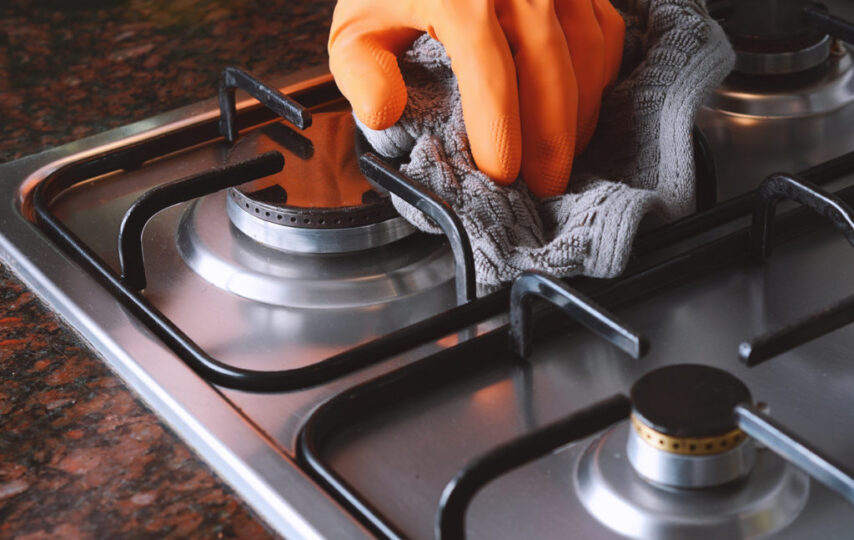When the gas ports on the burners get blocked, interfering with the flow of gas, gas stoves lose their efficacy. A blocked gas burner will provide a faint flame or, in rare circumstances, no flame if it is extremely filthy. Fortunately, cleaning gas burners is a simple task. Cleaning a gas stove requires a bit more time and work, but there are certain methods you can do to make it less dirty. Let us understand exactly how to clean gas stove top?
What are you going to need to clean the gas stove top?
There is considerable variety in how manufacturers recommend cleaning gas stove burner heads, however the following items will work for most stoves:
- Soap for dishes
- Sodium bicarbonate
- scourer without abrasives
- old toothbrush
- a paperclip
Let’s begin with the process of How do you clean gas stove top?
1. Carefully read the manufacturer’s instructions before cleaning your gas stove top.
Knowing how to take care of your appliance will go a fair way toward safeguarding your kitchen assets. The product handbook that came with your range will tell you which portions are safe to remove for cleaning, making your task easier. The handbook may even advise cleaning chemicals (or products or ingredients to avoid). This is a wonderful place to start if you want to learn how to maintain and unclog your gas burners. If you don’t have the hardcopy of the manual, you should be able to find it on the manufacturer’s website.
2. Take off the burner caps.
Before you begin, turn off the gas valve if you have an older stove with a hanging pilot light. A detachable ceramic disc that rests on top of the burner and serves to disperse the flames is common on gas burners. If that’s the case, simply remove this disc from the burner (naturally, you need to make sure the burners are completely cool before doing so).
3. Take off the burner heads.
The burner head rests on the venturi tube underneath the caps. Lift the burner heads up to remove them. If your stove has this configuration, be careful not to damage the ignition electrode.
4. Soak the components
Soak the burner heads and caps for 30 to 40 minutes in a solution ofantibacterialdishwashing liquidsoap and warm water. This will aid in the removal of any hardened material.
5. Rub the burner heads and caps together
Scrub all surfaces of the burner heads and caps to remove food or grease stains. with a non-abrasive scouring pad and an old toothbrush. If material remains in the port holes, remove it using a straightened paper clip, being cautious not to harm the metal. Don’t delve too far into the portholes; you’re only attempting to unclog them. Never use a toothpick since the wooden spout might shatter and severely block the ports.
Pro tip!
Never clean the stove burner components with bleach or steel wool.
6. Rinse the components
All parts should be properly rinsed under running water, shaken to remove excess water, and then dried with a cloth. Allow all parts to thoroughly air dry before reassembling the burners. While they are drying, you may move on to cleaning the stove’s other components, such as the grates and drip trays. The same soaking and scrubbing procedure will be used to clean these areas as well.
7. Replace the burners.
Reassemble the drip trays, burner heads, lids, and racks after they are totally dry. When reinstalling the burner nozzles on electronic ignition stoves, be careful not to break the ignition electrodes.
Conclusion
Pro tip on how to clean the gas stove grill? The steam generator may be used without removing the grill. You can clean the gadget with a short, hard brush. Once the temperature is adjusted below 140 degrees, you must first steam a tiny surface to ensure that you have enough exposure time. You can also observe how the steam breaks down the fat. Finish by wiping the rack down with a sponge. If necessary, repeat.
If your family has a car, you may use the car engine cleaner; however, it should be put to a sponge first and then very gently wiped on the grill. Finally, it’s only a matter of rinsing with plenty of water and then drying it.
FAQs
How Often Should You Clean the Gas Burners on Your Stove?
The method is really basic and easy to use. Only when gas flow is obstructed, like when food residue spills over the edges of pots and pans and clogs the ports around the periphery of the burner heads, can problems develop. If left untreated, this food residue can harden and become difficult to remove. The general guideline is to clean your gas burners anytime the flame gets uneven or becomes yellow. Aside from that, cleaning the burners once a month should be enough.
How can I make a gas stove stainless?
If there is one thing that will make cleaning the gas stove much faster and easier, it will be to make it less dirty. However, it is rather problematic in this sort of kitchen since, with a flame, it is extremely difficult to remove the remnants that may fall or rapidly collect the liquids when they overflow, for example.
As a result, wherever feasible, attempt to wipe up what is dropping while taking care not to burn yourself. You may also reduce the heat for a few seconds to make the flame smaller.
To minimize as much splashing as possible, use the lids on pots, pans, and pans.
One of the most well-known and nearly foolproof methods is to line the base of the kitchen with aluminum foil, leaving room for the gas outlet and the burners or stoves and grills as usual.
Everything that leaps or falls will stay on the paper, rather than ruining the kitchen. Remove it once you’ve finished your preparations and the kitchen is cool. In this instance, all you’ll need to do is wipe down the gas stove with a towel and clean the grates and burners if they’ve grown dirty.
What are some pointers on how to clean gas stove top?
- The blocked jets are uncovered using a copper wire from a cable; never with needles since they are difficult to remove if they break.
- The burner bases feature clamps that open and close the air inlets, allowing the air-gas combination and, in particular, the calorific strength of the flame to be controlled.
- City gas jets have bigger apertures than butane jets; by switching them, the kitchen may be utilized as a cylinder and vice versa.
- Never use flames to detect gas leaks; instead, use soapy water to see whether it bubbles.



